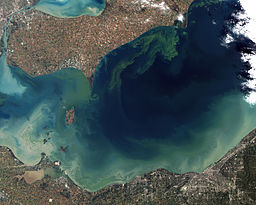Harmful algal blooms are increasing in size and frequency—but they are reversible. Listen up:

Pretty colors infecting our waters. (via J. Allen and R. Simmon, NASA Earth Observatory)
When swimming in the blue, stray away from the stinky green stuff known as algal blooms, which occur when large amounts of algae produce toxins. While water treatment facilities can successfully treat public drinking supplies, the toxins can cause liver damage if untreated water is ingested.
In the Great Lakes, the culprit is often blue-green algae.
The good news: Thomas Bridgeman, a professor at the University of Toledo, says that because the size of the blooms are directly correlated with the amount of runoff into the lakes, there is a solution.
“These blooms are reversible,” Bridgeman explains. “If we can find a way to keep fertilizers, particularly phosphorous, from entering our waterways and our lakes, the blooms will disappear within just a couple of years.”
So, let’s hear it for the cities and states that are beginning to do just that.
Get schooled:
- Get the 411 on harmful algal blooms from the EPA
- Check out what NOAA has to say about tiny plants with a toxic punch
The fine print:
- This segment was produced in partnership with Cornell’s Atkinson Center for a Sustainable Future




